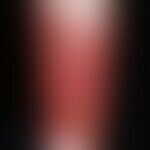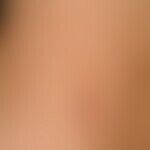Synonym(s)
DefinitionThis section has been translated automatically.
Acute or chronic photochemical light dermatosis of varying degrees of acuteity, induced by internal or external photosensitizers and sharply limited to the exposed skin areas, without immunological basis (important: no previous sensitization). See also Table 1.
ClassificationThis section has been translated automatically.
Depending on the clinical morphology and the time course of the reaction, 4 types of phototoxic reactions can be distinguished:
- Immediate or delayed reaction: Urticarial reaction, which is immediate or delayed. Clinical: immediate urticarial erythema with stinging and burning during exposure (smarting); erythema or urticae; triggers: tar, pitch, anthraquinone dyes, benoxaprofen, amiodarone, chlorpromazine.
- Sunburn-like reaction (corresponds to a dermatitis solaris): Trigger: quinolone, chlorpromazine, amiodarone, benoxaprofen, hydrochlorothiazide, quinidine, demethylchlortetracycline and other tetracyclines.
- Delayed erythema possibly with blistering: Often subclinical and only noticeable by hyperpigmentation. Trigger: Psoralene (phytophotodermatitis; see below dermatitis pratensis, Berloque dermatitis).
- Pseudoporphyria: Increased vulnerability of the skin with blistering after banal traumas. Triggers: Nalidixic acid, furosemide, tetracyclines, naproxen, amiodarone.
You might also be interested in
ClinicThis section has been translated automatically.
The clinical symptoms vary with the triggering agent, its mode of application (external, internal) and the intensity of UV exposure. Various photosensitizers (e.g. coal tar, chlorpromazine) can trigger an immediate phototoxic reaction with an erythematous to urticarial local reaction sharply limited to the light-exposed areas, with stabbing or burning pain.
Other phototoxins induce a delayed, sunburn-like reaction (starting about 6-8 hours after exposure). These include: tetracyclines, non-steroidal anti-inflammatory drugs. Tetracyclines can induce distal phototoxic onycholysis.
In the case of furanocoumarins, dermatitis may occur after several hours or, less frequently, only after several days.
In various reactions the acute phase is regularly followed by sharply defined hyperpigmentations (stimulation of melanin synthesis) which can persist for years (e.g. amiodarone). Often it is only the "cosmetically disturbing" residual hyperpigmentations that lead to a visit to the doctor. Amiodarone leads to grey-blue colour changes of the skin. This is caused by degradation products of amiodarone which accumulate in the skin as a function of radiation and lead to toxic melanocyte damage with melanocyte damage(pigment incontinence).
HistologyThis section has been translated automatically.
Differential diagnosisThis section has been translated automatically.
General therapyThis section has been translated automatically.
External therapyThis section has been translated automatically.
Medium strength glucocorticoid creams such as 0.1% triamcinolone cream R259, 0.05% betamethasone V lotio R030, 0.25% prednicarbate cream (e.g. Dermatop), methylprednisolone cream (e.g. Advantan).
Internal therapyThis section has been translated automatically.
TablesThis section has been translated automatically.
Important phototoxic substances
Essential oils |
Cedar oil Lemon oil Lavender oil Linden oil |
Antifungals |
Bromosalicylic acid isopropylamide Tetramethylthiuram disulfide |
Disinfectants |
Dichlorodioxydiphenyl sulfide Tetrachlorosalicylanilide |
|
Dyes |
Acriflavine Bengal red Eosin Fluorescin Methylene blue Proflavin Riboflavin Rivanol Thiopyronin Trypaflavin |
Phenothiazines |
Alimemazine Chlorpromazine Levopromazine Mepazine Parazine Prochlorperazine Promazine Thiopropazate Thioridazine Triflupromazine |
Sulfonamides |
Sulfanilamide Sulfisoxazole |
Tar and tar components |
Acridine dyes Cyclic hydrocarbons |
Tetracyclines |
Chlortetracycline Dimethyl chlortetracycline Doxycycline Methacycline Oxytetracycline |
Other |
5-fluorouracil Methoxsalen (methoxypsoralene) Resorcinol derivatives Vinblastine Dacarbazine Vemurafenib Amiodarone Phenytoin Clofazimine Nifedipine |
Plants with phototoxic ingredients (furanocoumarins) |
Field bindweed (Convolvulus arvensis L.), bergamot (Citrus aurantium L. ssp. bergamia), buckwheat (Fagopyrum esculentum M.), angelica (Angelica archangelica L.), figs, garden rue (Ruta graveolens L.), St. John's wort (Hypericum perforatum L.), lovage (Levisticum officinale K.), masterwort (Imperatoria ostruthium L.), parsley (Petroselinum crispum M.), burnet (Pimpinella saxifraga L.), yarrow (Achillea millefolium L.), hemlock, celery (Apium graveolens L.), meadow hogweed (Heracleum sphondylium L.). |
LiteratureThis section has been translated automatically.
- Ferguson J, Addo A. A, Jones S et al (1985) A study of cutaneous photosensitivity induced by amiodarone. Br J Dermatol 113:537-549
- Hölzle E, Plewig G (1982) Photoallergic contact dermatitis caused by benzophenone-containing sunscreen preparations. Dermatologist 33:391-393
- Jackson R. T., Nesbitt L. T. Jr, DeLeo V. A (1980) 6-Methylcourmarin photocontact dermatitis. J Am Acad Dermatol 2:124-12
- Mahler V (2015) Contact eczema. Act Dermatol 40: 95-107
- Schauder S, Ippen H (1986) Photoallergic and allergic contact dermatitis from dibenzoylmethanes. Photodermatolgy 3:140-147
Incoming links (53)
Actinic Prurigo; Ammi majus L; Angioedema histamine-mediated; Bergamot; Berloque dermatitis; Betamethasone valerate emulsion hydrophilic 0,025/0,05 or 0,1 % (nrf 11.47.); Bibernelle large; Bibernelle small; Carrot; Cartilage carrot; ... Show allOutgoing links (29)
Acetylsalicylic acid; Adverse drug reactions of the skin; Angelica; Berloque dermatitis; Betamethasone valerate emulsion hydrophilic 0,025/0,05 or 0,1 % (nrf 11.47.); Buckwheat; Celery; Dermatitis bullosa pratensis; Dermatomyositis (overview); Furanocoumarins; ... Show allDisclaimer
Please ask your physician for a reliable diagnosis. This website is only meant as a reference.













